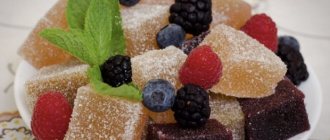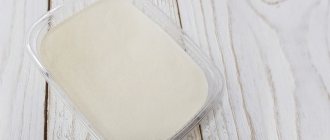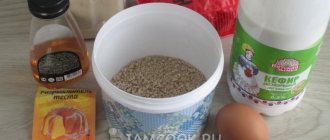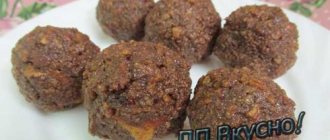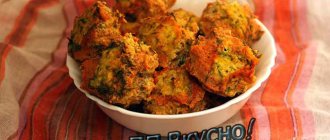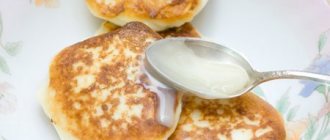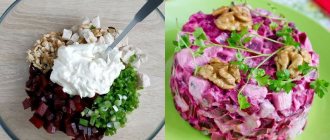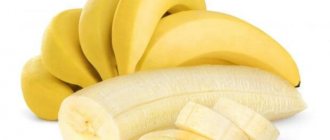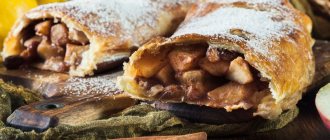Composition of marmalade
Marmalade was first made in France, but the prototype was the eastern Turkish delight, which began to be made hundreds of years ago from fruits and honey.
The ideal composition of marmalade: fruit puree, sugar and pectin. The latter is used as a thickener. It is not a synthetic substance, but a natural component of most fruits.
Natural marmalade is quite expensive, so there are budget options made using gelatin. Gelatin is made from animal cartilage and bones. It is much cheaper than pectin, and the delicacy with it is higher in calories.
Bright multi-colored marmalade looks beautiful and appetizing, but most often this is the result of artificial colors, which are of no benefit. The more inconspicuous the delicacy, the more attention it deserves, but in any case, carefully read the composition.
Varieties of marmalade
There are many ways to make marmalade. Calorie content per 100 grams depends on the type of treat. At a minimum, one should distinguish between jelly marmalade, jelly-fruit, fruit and berry, chewing and sandwich. There are also natural products and inexpensive options that are made using various additives.
Now about the energy value. The stereotype about the low value arose about thirty years ago, when marmalade was natural and its calorie content was really only 220-270 kcal per 100 grams.
Today, manufacturers use flavor enhancers, flavors and preservatives, which not only call into question the usefulness of the product, but also increase its nutritional value. The calorie content of marmalade in sugar, in chocolate, with fillings ranges from 350-450 kcal or more, depending on the ingredients.
At the same time, there is no fat in marmalade, which gives it an advantage over most other desserts. It is sweet enough that you can't eat too much of it, and one cube weighs about 15 grams and contains 35-60 kcal.
Homemade marmalade without sugar recipe with photos step by step
Homemade marmalade without sugar
Ingredients and how to cook
Unfortunately, your Javascript . This is a necessary element for most functions on our site. Contact your administrator to resolve this issue.
ingredients for 6 servings
The dish is designed for 6 servings.
Water
1 lmlstak.
(200 ml) tea.l.table.l.dessert.l. Total: in one serving in all servings in 100 g of composition
| Composition weight: | 100 gr |
| Calorie composition: | 57 kcal |
| Belkov: | 5 g |
| Zhirov: | 0 g |
| Carbohydrates: | 10 g |
| Used: | 33 / 0 / 67 |
| H40 / C60 / B0 | |
Cooking time: 6 hours
PT6H
Published by: UnicornSteak
Step-by-step preparation
Step 1:
First, pour the gelatin into a glass of warm boiled water. According to the instructions, my gelatin needs 40-60 minutes. for swelling. If you want a thicker marmalade consistency, just use a little more gelatin.
Step 2:
Oranges must be thoroughly washed and cut in half.
Step 3:
We will need to squeeze the fresh juice out of all the prepared oranges. I use a mechanical citrus juicer. But you can squeeze out the juice just with your hands.
Step 4:
No matter how hard I tried, bones still got into the fresh juice. Therefore, I suggest straining the juice through a sieve. At the same time, the pulp will be removed. You can also use gauze folded in several layers.
Step 5:
Wash and peel the bananas. Banana in this
1000.menu
Chewing marmalade
People who prefer desserts that are not too sweet choose chewing marmalade, the calorie content of which ranges from 338-400 kcal per 100 grams. Another plus is that the treat does not stick to your hands.
The composition includes molasses, sugar, citric acid, gelatin, pectin and a wax-fat mixture (90% vegetable fat and 10% wax). The latter is needed so that the sweetness has a shiny and non-sticky surface.
Dessert is a good substitute for chewing gum after eating, as it cleans and whitens teeth.
Homemade marmalade
If you want marmalade that is truly low in calories, make it yourself.
Take three apples, a tablespoon of gelatin or pectin, a pinch of cinnamon (optional). Peel the apples and cut into slices. Microwave them for 10 minutes, then puree them. Add cinnamon, gelatin and stir until the latter is completely dissolved.
Place the resulting mass into molds. Let it cool to room temperature. Next, place it in the refrigerator and keep it there until it hardens. As a result, you will get apple marmalade, the calorie content of which is only 60 kcal.
If you want to prepare a sweet that resembles the “store-bought” version, then prepare 300 ml of any juice (freshly squeezed or from the store), 150 ml of water, 400 g of sugar, 50 g of gelatin.
Pour the juice into a saucepan, heat, add gelatin and cook for 7 minutes. In another saucepan, combine water and sugar, bring the mixture to a boil and simmer over low heat until the sugar is completely dissolved. Then pour the boiling syrup into the first pan and stir thoroughly to dissolve the gelatin. Strain the resulting mass, pour into molds and let cool. Once hardened, remove the marmalade from the molds and roll in sugar.
It is clear that this will no longer be dietary marmalade. The calorie content will be at least 250 kcal per 100 g, depending on what juice was used.
Marmalade for diabetics: rules of preparation and consumption, recipes without sugar
With diabetes, restrictions are placed on many sweets because they increase blood sugar levels, but marmalade is one of the few exceptions. This is a healthy dessert that stimulates digestion, lowers cholesterol, and removes heavy metals and pesticides. What kind of marmalade can be eaten, and how to prepare the delicacy yourself, we will consider further.
Is it possible to eat?
Marmalade is a healthy sweet if it is made using the correct technology from natural products and thickeners. The calorie content of one such candy is about 10 kcal, and the glycemic index is low - from 10 to 30 units, which is due to the fruits used in the preparation. The most popular among them:
- apples – 30 units;
- plums – 20 units;
- apricot – 20 units;
- pear – 33 units;
- black currant – 15 units;
- red currant – 30 units;
- cherry plum – 25 units.
To fill the daily need for sweets, which is necessary for the production of serotonin - the hormone of happiness, a diabetic can eat up to 150 g of natural marmalade, but preferably in the first half of the day, in order to expend the energy received before going to bed.
It is important to note that if you have diabetes, you will have to give up store-bought marmalade, since it contains sugar.
In addition, for the rich taste and bright appearance of candies, manufacturers often use food acids, dyes and flavors, which are strictly prohibited for diabetics.
To be sure that the marmalade is natural and safe, you can prepare it yourself.
Selection of products and cooking principle
To make marmalade tasty and healthy for diabetics, the main thing is to choose the right products. So, the recipe may include the following ingredients:
- Fruits . Preference is given to those fruits that contain large quantities of pectin, since it breaks down fats, removes harmful substances and reduces blood glucose levels. Moreover, the more pectin, the denser the marmalade base will be. Based on this criterion, the preferred fruits are apples, pears and citrus fruits (lemons, oranges, grapefruits).
- Syrups . Marmalade can be made from berry or fruit syrup, which is brewed from freshly squeezed juice. In addition, gummy candies based on hibiscus tea, which has a pleasant sour taste, are useful for diabetes. It lifts your spirits and restores your strength.
- Stevia . This is a natural herbal sugar substitute that can be purchased at the pharmacy. Stevia is several times sweeter than sugar, but does not increase blood glucose levels. In addition, it has many beneficial properties, including giving a feeling of satiety and improving metabolic processes.
Analogues of stevia are other sweeteners - fructose, xylitol, sorbitol.
- Gelatin . This is a thickener that gives marmalade a dense jelly-like consistency. Gelatin is rich in phosphorus and calcium, helps strengthen bone tissue, and also improves brain function and memory.
- Agar-agar . This product is made from dried seaweed. It is also called vegetarian gelatin. It has few calories, is well absorbed, and also contains various beneficial substances, including iodine. It is important to note that agar-agar has a higher density than gelatin, and therefore is more suitable as a thickener for marmalade.
The technology for making marmalade boils down to boiling the selected fruits, grinding them to a puree, mixing with a thickener and sweetener, boiling them again and cooling them, pouring them into molds. Since everything is so simple, everyone can prepare a delicacy to their own taste.
Delicious recipes
Depending on the main ingredients used, gummies can vary. In any case, properly prepared candies should have a transparent structure and, when pressed, quickly take their original shape. Their recipes can be found below.
Based on hibiscus and gelatin
The cooking procedure is as follows:
- Pour 7 tbsp. l. hibiscus 200 ml boiling water. Leave for about 30 minutes.
- Dissolve 25 g of gelatin in a small amount of warm water and leave until it swells.
- Strain the hibiscus, add sweetener to taste and bring to a boil.
- Mix tea and gelatin solution. Mix thoroughly and pass through a sieve.
- Pour the syrup into molds and place in the refrigerator until cool. As a rule, this takes up to 2-3 hours.
Hibiscus can be replaced with any natural juice without sugar. For example, delicious marmalade can be made from cherry juice according to the recipe from the video:
Citrus with stevia
You can take oranges, tangerines, lemon. Prepare marmalade according to the following instructions:
- Peel the fruit and cut into pieces.
- Prepare half a glass of stevia infusion or solution. Pour this liquid over the fruit and cook without bringing to a boil.
- Grind the fruit mass in a blender, and then add the prepared gelatin (diluted in water and swollen). Place on the fire, bring to a boil and immediately remove from heat.
- Pour the mixture into molds and cool.
In this recipe, citruses can be replaced with berries - raspberries, strawberries and blackberries.
Strawberry agar-agar based
For this recipe you will need:
Northern Lights - prevention of diabetes (consultation) More details Mycelix - for diabetes. Hurry up to get it for free! More details
- strawberries – 250 g;
- agar-agar – 2 tbsp. l.;
- water – 300 ml;
- sweetener to taste.
The delicacy is prepared simply:
- Pour water over agar-agar and let it swell. Then bring to a boil and cook until jelly-like.
- Grind the strawberries in a blender until pureed, add sweetener and mix.
- Transfer the strawberry mixture to the agar-agar and boil for a couple of minutes.
- Pour the hot mixture into molds and cool.
You get delicious marmalade candies. You can make them not only from strawberries, but also from any berry puree.
It is suggested to prepare marmalade based on agar-agar according to the recipe from the video:
Apple
The recipe differs in that it does not involve the use of a thickener, because it uses natural pectin. But it is important to consider that you need to use very ripe and even overripe apples.
Preparation:
- Chop and core 1 kg of apples, but do not throw them away. Do not remove the peel.
- Boil the cores separately in a small amount of water, then mash and rub through a sieve. The result is a liquid puree, which acts as natural pectin.
- In a saucepan, combine pectin with chopped apples (you can add a little more water) and place on very low heat, stirring constantly so as not to burn. When the apples are boiled, add fructose to taste and cook until the apple mixture sticks to the spoon.
- Grind the pulp with a blender until smooth. Next, place the entire mass in a layer on a baking sheet covered with paper.
- Dry the marmalade in the oven with the door ajar at a temperature not exceeding 80 degrees in 2 approaches. So, keep the baking sheet for about 2-3 hours in a hot oven, then turn it off. Repeat drying after a few hours.
- After drying, cut the finished marmalade into pieces and layer them in a small jar. Keep refrigerated. This marmalade is very good for health.
Using a similar recipe, you can make marmalade from 500 g of apples and 250 g of pear.
Mycelix - for diabetes. Hurry up to get it for free! More details
Berry
Can be prepared from any berries to your taste:
- Wash and sort the berries. Squeeze the juice out of them, put it on low heat and cook until it becomes a thick jelly.
- Spread the mixture in a thin layer on a baking sheet, which has been previously lined with parchment.
- Move the baking sheet to the oven and dry the marmalade with the door open at a temperature of 70-80 degrees.
- Once the layer is dry, it can be formed into a roll and cut into slices. If desired, the mixture can be squeezed out using small cookie cutters.
Keep the finished marmalades in the refrigerator in a tightly closed container.
Vegetable
Such marmalades will appeal to lovers of culinary experiments. Wash 2 kg of tomatoes, remove the stems and finely chop. Transfer the mixture to a saucepan, bring to a boil and pass through a sieve.
Add sweetener to taste to the resulting paste and boil to obtain a thick consistency.
Next, pour it in a thin layer onto a baking sheet lined with parchment, dry it slightly and place in the refrigerator until cool.
: 3 sugar-free marmalade recipes
The following video offers different recipes for delicious and healthy gummies:
Natural marmalade is an excellent sweet for diabetics because it does not cause spikes in blood sugar. You can eat 2-3 pieces of the treat in the first half of the day - for breakfast or lunch (in the break between breakfast and lunch). It will lift your spirits and satisfy your body's need for sweets.
PreviousNext Did this article help? Rate it Loading...
Source: https://AboutDiabetes.ru/marmelad-dlia-diabetikov-pravila-prigotovleniia-i-ypotrebleniia-recepty-bez-sahara.html
Sandwich marmalade
This delicacy, as the name suggests, is intended to be spread on bread, and therefore looks like a bar similar to butter.
The structure is slightly different from regular marmalade: the sandwich version is a little softer and easily spreads on the surface of the bread. But the caloric content is approximately the same - 310 kcal per 100 grams. However, the remaining components of the sandwich should be added to this figure, and if you are watching your figure, then God forbid that this is yeast-free bread with bran, and not a fresh bun greased with butter.
Beneficial properties and harm
Marmalade contains vitamins B2 and PP, as well as phosphorus, iron and calcium.
Pectin normalizes intestinal microflora, improves digestion, removes harmful substances from the body, has a bactericidal effect, and reduces the level of “bad” cholesterol.
If the composition includes gelatin, it helps improve the condition of the skin and hair. If agar-agar is used as a thickener, such marmalade has a beneficial effect on the thyroid gland, improves intestinal motility and normalizes liver function.
The dessert also has a mild diuretic effect, which helps cope with swelling.
Finally, marmalade helps relieve stress.
Dessert can only be harmful if you have an individual intolerance. In other cases, problems can arise only with excessive consumption: those with a sweet tooth will easily develop caries. Diabetics should only eat marmalade that uses fructose instead of sugar.
Now you know the whole truth about marmalade. Bon appetit!
Today I’ll tell you how to make marmalade at home, according to a dietary recipe. In addition to the fact that this orange marmalade is a figure-friendly sweetness, it also looks impressive. It will not be easy for an inexperienced person to understand how this is done, and your girlfriends will beat you up, begging for the recipe for orange marmalade.
When following a diet, every person experiences some inconvenience due to the lack of opportunity to enjoy sweets. Of course, this is a big problem, but not for regulars of our site. Dietary marmalade with natural juice, you can eat it even while following a strict diet. The secret of the delicacy is in the ingredients used.
It is worth mentioning that orange marmalade made according to this recipe can be consumed at any time of the day, since it contains virtually no calories. In addition, it can be prepared as a dessert for girls' get-togethers. A gathering of young Vasilis will appreciate a dietary dessert with a minimum of calories.
You can surprise your friends not only with marmalade - they will appeal to every beauty who cares about her appearance. You can see more in the article at the link.
Is it possible to eat marmalade if you have diabetes?
Marmalade is a culinary product and a very tasty dessert that has the consistency of jelly. Marmalade for diabetics is only allowed if it has been prepared at home.
The product contains natural fruits and berries (pectin), gelatin or agar-agar, so it is rich in vitamins B, K and E, iron, calcium, fluorine, phosphorus, potassium and magnesium. It is better for diabetics to consume marmalade in the first half of the day and not to overeat more than 150 grams per day.
The delicacy sold in the store is made with sugar, food acids, artificial flavors and dyes - such a product is prohibited for diabetics.
Beneficial features
Marmalade consists of gelatin, pectin and agar-agar. Pectin is a fiber of plant origin, considered the health worker of the digestive system and a storehouse of vitamins.
Gelatin is a product of processing the connective bone-cartilaginous tissue of domestic animals; it contains rare amino acids (glycine, proline and lysine) and acids (alanine, aspartic).
Agar-agar, obtained from seaweed, is rich in iodine, which improves the functioning of the thyroid gland. When using marmalade for diabetics:
- intestinal motility improves, constipation may disappear;
- lipid and carbohydrate metabolism is restored;
- cholesterol formation is reduced, which reduces the risk of atherosclerosis;
- cleanses the liver and kidneys (there is a slight diuretic effect);
- toxins, radionuclides, waste and pathogenic bacteria are removed;
- strength is restored after exercise;
- brain function is normalized;
- immunity is strengthened;
- the nervous system is restored;
- the healing process of fractures and cracks is accelerated;
- the skin is rejuvenated, the condition of hair and nails improves.
Healthy sweet recipes
If you are diagnosed with diabetes, it is useful to eat homemade marmalade. It can be made from seasonal fruits and berries that contain pectin: apples, red and black currants, plums, without added sugar, which is very important for diabetes. The recipes are very easy to follow and are within everyone's price range. They take the fruits, wash them, sort them and, if there are seeds, remove them.
Natural gummies can be made from fresh fruits and berries that are useful for this disease.
Prepared fruits or berries are immersed in water, which should only cover them, and boiled for about half an hour.
The finished berries are cooled, passed through a sieve or blender and the resulting puree is again placed on low heat and stirred constantly to avoid burning.
It is necessary to evaporate all the liquid, then put the finished mass on a plate, having previously formed balls or lozenges. Dry in the room until the marmalade is ready.
You can also make marmalade for diabetes from the juice of berries or fruits. After pre-washing and sorting the berries, the juice is squeezed out of them, which is boiled over low heat until the consistency of thick jelly.
The mass is poured onto a sheet covered with parchment and dried in the oven with the door open. At the end of cooking, a thin layer of marmalade remains, which can be rolled and cut or squeezed out with cookie cutters.
Store in a tightly closed container in the refrigerator.
Stevia marmalade recipe for diabetics
If it’s not sweet enough for a diabetic, when preparing delicacies from fruits and berries, you can add a sweetener - stevia. It has antimicrobial and antibacterial effects.
The recipe for marmalade with stevia is simple, for this you take: apples - 500 grams, pears - 250 grams, plums - 250 grams (about 1 kg of fruit in total). Wash the fruits, peel them and remove the seeds. Chop into small cubes and add water to just cover the fruit.
Once cooked, cool and turn everything into puree. Then add stevia to taste and boil until thick. Pour into molds and wait until it hardens.
Using gelatin
You can also make gelatin-based marmalade.
Marmalade with gelatin is also possible for type 2 diabetes. It is prepared very simply and quickly. Take instant gelatin in a small packet and pour it according to the preparation indicated on the package.
Grind the berries: raspberries, strawberries, blackberries into puree, add a little water and if sweetened (optional), add a sweetener and put on fire. After boiling, add gelatin and bring to a boil.
Remove from heat, pour into molds or rosettes and put in a cool place to harden completely.
With the addition of hibiscus
Hibiscus tea marmalade is very unusual and tasty.
The method of preparing it is very easy: you will need 5 tablespoons of hibiscus petals, water, for brewing tea - 300 grams, instant gelatin - 1 package (25 grams), sugar substitute - to taste.
Brew tea, and while it steeps, add gelatin to swell. Then the tea is filtered and everything is mixed. Bring to a boil and pour into molds. Cool to room temperature and put in the refrigerator until completely solidified.
How to make diet marmalade at home
If you want to make ordinary, non-diet marmalade at home, you will have to slightly adjust the recipe. To do this, simply replace the stevia with granulated sugar. Determine the amount according to your taste, depending on the natural sweetness of the oranges, usually about 2 tsp is required.
- Making dietary marmalade at home from oranges is as easy as shelling pears. Wash the fruits thoroughly with hot water. Cut the fruit lengthwise into wedges.
- Now you need to carefully peel out the orange pulp without damaging the skins. Place the bowl as juice will leak out during the process. Squeeze the pulp thoroughly; the resulting juice must be strained and set aside.
- Fill the pomace with water, put on fire and boil for 10-15 minutes. Strain the broth, add sweetener and agar-agar. Return the mixture to the heat and bring to a boil, simmer for about two minutes. Stir the sour liquid constantly.
- After removing the orange marmalade from the heat, pour in the previously squeezed juice. Mix well and taste for sweetness, you may need to add a little sahzam.
During the hardening process, it loses its sweetness, so the mixture must be made sweeter than necessary.
- Pour the finished mixture into orange peel hemispheres and let the marmalade harden.
- The orange jelly will be ready in an hour. Agar hardens well at room temperature.
Now you know how to make marmalade at home for dietary purposes without any hassle.
You can treat yourself to this marmalade with any balanced diet. The exception is such strict nutrition systems as similar ones.
You can also make sweets as a dessert on a diet. Reserved for lovers of fruit desserts
Is it possible to eat marmalade while losing weight? Definitely yes. Marmalade is one of the healthiest desserts both for weight loss and normal nutrition. Judge for yourself!
The calorie content of regular marmalade is about 220-270 calories per 100 grams. For comparison, 100 grams of chocolates contain about 500 calories, and 100 grams of cake contain from 350 to 600 calories, depending on the type of cake. So even the most ordinary marmalade can be safely consumed without worrying about your figure. This delicious dessert contains pectin, which is extremely beneficial for our body. The thing is that pectin is obtained from apples and fruits, so these sweets can rightfully be considered natural. Pectin lowers cholesterol levels and helps eliminate various diseases of the gastrointestinal tract.
Does marmalade contain gluten?
This question worries many who adhere to a gluten-free diet. Pectin itself does not contain gluten, but you should avoid marmalade with powdered sugar, as it may contain gluten. Just choose pure marmalade without any additives or powders.
PP marmalade can be prepared from absolutely all fruits and berries. When cooking, you can use not only fresh berries, but even frozen ones. Recipes for low-calorie marmalade based on natural juice are also very popular.
Despite the fact that marmalade does not contain many calories, there are recipes for preparing this dessert that will help you further reduce its calorie content. These recipes do not contain sugar and fit perfectly into a healthy diet.
PP marmalade contains approximately 40 to 70 calories per 100 grams!
Delicious and easy recipes for low-calorie desserts
For the sake of a spectacular appearance, will you have to give up your favorite sweet treats forever? No, it’s enough to learn how to prepare low-calorie desserts from healthy and wholesome foods. Below you will find recipes that you can pamper yourself with even on the most restrictive diet!
How to make sweets less low-calorie?
Any recipe can be made into a fairly low-calorie dish. To do this, you need to replace in the composition:
- premium white flour, whole grain or oatmeal;
- butter or margarine for fruit puree;
- cream or sour cream for natural yogurt;
- whole eggs for egg whites (at the rate of 1 egg - whites from 2 eggs);
- sugar with a calorie-free sweetener, such as stevia.
Find out what the lowest-calorie sweets are here.
Low-calorie cottage cheese desserts
Many low-calorie desserts are based on cottage cheese. And it is right! Cottage cheese, especially low-fat cottage cheese, is the most dietary product. It is protein-rich, low-calorie, and can be used as an ingredient in dough, jelly, soufflé or cream—an ideal base for dessert.
Cake “Broken Glass”
Its undoubted advantage is the possibility of creativity: replacing components both in the base and in fillers. And the simplest low-calorie option looks like this:
Compound:
- cottage cheese 0.2% - 200-250 g;
- liquid yogurt 0% - 400-450 g;
- sweetener - 40 g;
- gelatin - 30 g;
- three types of fruit jelly.
Preparation:
- Prepare jelly. It’s easier to do this using a store-bought instant product - dissolve the powder in boiling water, as indicated on the package, and cool until it hardens. If you want to make a dessert without chemicals, you can use natural fruit juices and gelatin for jelly.
- Dissolve the gelatin for the curd base in a glass of water, bring to a boil, and cool.
- Using a blender or mixer, beat the cottage cheese with sugar and yogurt, stir in the gelatin.
- Remove from the refrigerator and cut fruit jelly of three colors into pieces of different sizes.
- Line a mold or a regular bowl with cling film, place pieces of multi-colored jelly in a chaotic order, fill with curd base and place in the refrigerator until completely set.
- Before serving, turn the cake over onto a plate and remove the film. You can sprinkle with coconut or grated chocolate.
From the specified amount of products you will get approximately eight servings of a beautiful and tasty dessert.
Nutritional value per 100 g:
- proteins 5.6 g
- fat 0 g
- carbohydrates 8.1 g
Total: 54.5 kcal
The composition of such a cake can be changed and supplemented with fruits, marshmallows, and marmalade. The base may not be cottage cheese, but entirely yoghurt or milk.
In the following video you can clearly see how a 5-color jelly cake is prepared, but remember that the low-calorie recipe does not use cream, but 0% yogurt:
Diet cake “Potato”
Fans of chocolate taste will appreciate the dietary “Potato”:
Compound:
- cottage cheese 0.2% pasty - 200 g;
- wheat, oat or rye bran - 4 tbsp. l.;
- cocoa powder - 4 tbsp. l.;
- vanillin;
- sweetener to taste.
Preparation:
- Combine cottage cheese, bran, vanillin and sweetener, which should first be dissolved in a couple of tablespoons of water.
- Knead the mixture thoroughly.
- Form “potatoes” and roll in cocoa.
You can add nuts - walnuts or almonds, and also add a couple of vanilla crackers, ground in a food processor. It will be tastier, but also higher in calories.
Nutritional value per 100 g (without nuts and crackers):
- proteins 12.9 g
- fat 2.1 g
- carbohydrates 3.8 g
Total 85.4 kcal
Cottage cheese marshmallows
Due to the presence of pectin in it, any marshmallow can be called, if not dietary, at least an acceptable treat for those with a sweet tooth who are losing weight. And cottage cheese marshmallows can be eaten at any time without fear - this is perhaps the lowest-calorie dessert.
Compound:
- low-fat cottage cheese - 400 g;
- milk 1.5% - 120 g;
- sweetener to taste;
- gelatin - 15 g;
- black currants or raspberries - 50 g.
Preparation:
- Dissolve gelatin in milk with sweetener according to the instructions on the package.
- Rub the berries through a sieve.
- Combine cottage cheese with berry puree and gelatin, beat thoroughly, pour into mold and place in refrigerator to harden.
- Before serving, cut marshmallows into portions.
Nutritional value per 100 g:
- proteins 13.1 g
- fat 0.5 g
- carbohydrates 2.9 g
Total 68.6 kcal
You can see how beautiful curd marshmallows are prepared in the video:
“Raffaello” from cottage cheese
Classic “Raffaello” is delicate in taste, but very heavy on the waist - their calorie content exceeds 600 kcal per 100 g. Diet sweets made from cottage cheese are another matter.
Compound:
- low-fat cottage cheese - 150 g;
- sweetener to taste (usually 2-3 g);
- low-fat coconut flakes - 20 g;
- almonds - 6 pcs.
Preparation:
- Beat the curd well until smooth and paste-like.
- Add sweetener and most of the coconut flakes.
- Divide the mixture into six parts.
- Place a nut into each portion, form a ball around it, and roll in the remaining shavings.
Nutritional value per 100 g:
- proteins 14.3 g
- fat 8.4 g
- carbohydrates 5.8 g
Total 153.9 kcal
If you use regular coconut flakes, the calorie content will be 166.3 kcal per 100 g. Not much, but it is important to control the amount in this dessert. If you exceed the norm, the calorie content will increase greatly due to the high fat content.
Fitness "Raffaello" - it's possible! This can be seen in the following video:
Panna cotta with berries - a low-calorie dessert made with milk
Panna cotta is not just a delicious dessert, it is a real haute cuisine dish that is on the menu of any respectable restaurant. It’s great that this delicate and airy sweetness can also be prepared in a dietary version.
Compound:
- milk 3.2% - 230 ml;
- skimmed milk powder - 10 g;
- berries (strawberries or raspberries) - 200 g;
- gelatin - 11 g;
- sugar - 45 g;
- vanilla sugar - a bag.
Preparation:
- Dissolve a sachet of gelatin in 100 ml of water.
- Increase the concentration of milk at the expense of dry milk, boil it with sugar and vanilla sugar for several minutes, add diluted gelatin.
- Bring to a boil, but do not boil.
- Pour into molds and leave to cool - first at room temperature, and then in the refrigerator until completely set.
- Before serving, immerse the molds in hot water for a couple of seconds, turn them over onto dessert plates, and pour over the pureed berry sauce.
If you really like sweets, replace the sugar in the dish with stevia, and beat the 45 grams specified in the recipe with berries for the sauce.
Nutritional value per 100 g:
- proteins 3.6 g
- fat 1.3 g
- carbohydrates 13.7 g
Total 80.0 kcal
Low-calorie baked goods
The following recipes are great for breakfast or a pre-workout snack.
Muesli cookies
To prepare these cookies, you can use ready-made muesli or a mixture of Hercules flakes with dried fruits and nuts.
Compound:
- muesli - 200 g;
- egg whites - 100 g;
- spices to taste (cardamom, cinnamon, ginger, vanilla);
- milk 1.5% - 75 ml;
- sweetener;
- ground coffee - 1-2 tsp.
Preparation:
- Combine all ingredients (stir sweetener well in milk first).
- Let sit for half an hour, stirring occasionally.
- Place on a silicone mat in portions with a spoon, giving the shape of round cookies, or fill the mold with the resulting dough, and after baking, cut the cake into pieces.
- Bake at 170-190 degrees for about twenty minutes.
Nutritional value per 100 g:
- proteins 9.4 g
- fat 2.1 g
- carbohydrates 37.0 g
Total: 205.7 kcal
Fruit and oatmeal cookies
If you replace muesli with oatmeal in the previous recipe, and eggs and milk with fruit puree or kefir, you will get a different dietary dish:
Composition 1:
- oat flakes - 150 g;
- overripe bananas - 2 pcs. (this is approximately 180 g).
Per 100 g: B 6.0 g + F 2.9 g + U 34.2 g = 187.2 kcal
Composition 2:
- oat flakes - 150 g;
- applesauce - 200 g;
- white of one egg.
Per 100 g: B 5.4 g + F 2.6 g + U 24.1 g = 143.8 kcal
Composition 3:
- oat flakes - 150 g;
- kefir 0% - 200 g;
- white of one egg;
- sweetener, vanilla, cinnamon, ginger.
Per 100 g: B 7.0 g + F 2.4 g + U 21.9 g = 140.1 kcal
By adding dried fruits and nuts, the taste of the cookies improves, but their calorie content also increases accordingly.
You can also use the recipe for curd oatmeal from the video:
Fruit pie on lavash
Thin Armenian lavash provides great scope for imagination - you can use it to prepare many dishes, including desserts. For example, no-bake fruit pie.
Compound:
- thin lavash - 200 g;
- apple and/or pear - 200 g;
- 100 g of water and a tablespoon of honey / 100 g of low-fat yogurt and one banana.
Preparation:
- Peel the fruits and cut them into thin, almost transparent slices.
- If you are preparing a version with honey, dissolve it in water and pour this water over the fruit for 15 minutes.
- Cut the pita bread into several equal parts.
- Moisten each “cake” in honey water, place on a plate and cover with a thin layer of fruit.
- Leave the pie in the refrigerator overnight and by morning the delicate, refreshing dessert will be ready.
You can make a cream by whisking yogurt and banana. Then each layer of pita bread should be coated with cream, and slices of fruit should be placed on top. Also leave to soak overnight.
Nutritional value per 100 g:
- First option : B 2.9 g + F 0.5 g + U 24.7 g = 111.1 kcal .
- Second option : B 3.4 g + F 0.4 g + U 23.2 g = 107.3 kcal .
Lavash strudel
This recipe already requires baking, but is also prepared from pita bread - simple and quick.
Compound:
- Armenian lavash - 100 g;
- yogurt 0% - 100 g;
- apples - 400 g;
- lemon juice;
- any dried fruits and nuts - 50 g;
- egg white for greasing the strudel;
- powdered sugar - 5 g.
Preparation:
- Peel the apples and cut them into cubes.
- Sprinkle with lemon juice to prevent darkening, mix with nuts and dried fruits.
- Unwrap the pita bread, coat it with yogurt, add the filling and roll it into a roll.
- Bake at a temperature of 160-180 degrees for 30-40 minutes on a silicone mat or baking sheet lined with parchment.
- To prevent the finished pita bread from burning on top when baking, cook under foil or a lid, which should be removed 5-7 minutes before it is ready.
- Brush the top of the strudel with egg white, and when it is browned, remove from the oven and sprinkle with powdered sugar.
Nutritional value per 100 g:
- proteins 2.6 g
- fat 2.1 g
- carbohydrates 16.8 g
Total: 95.4 kcal
-recipe: Low-calorie ice cream
For many girls losing weight, the most difficult thing is giving up ice cream, especially in the summer. The great news for them is that making low-calorie healthy ice cream at home is not so difficult, following the recipe from the video:
Having these simple recipes for low-calorie desserts in your cookbook, you will definitely reach the desired number on the scale, and you will do it in a good mood, easily and joyfully. After all, a diet can be not just tasty, but even sweet!
Source: //diet-log.ru/nizkokalorijnye-deserty-v-domashnih-uslovijah/
PP marmalade - dietary recipe
- 350 grams of mango. This fruit is ideal for making tender and tasty marmalade. In this case, the amount of already peeled fruit is indicated.
- 15 grams of gelatin. It is best to use instant gelatin, so the cooking process will take much less time.
- 250 grams of water
- 2 scoops of fitparad
Pour gelatin into 100 ml of water, warm it up a little and add fitparad. The sweetener should dissolve properly in the gelatin. Blend the peeled mango using a blender. We need to get fruit puree of uniform consistency. Pour the remaining water into the resulting puree, mix thoroughly and combine with the gelatin mass. Now all that remains is to pour our dietary marmalade into molds and put it in the freezer.
Fructose as a sugar substitute
Fructose is often used in sweets for people with diabetes. It is worth noting that this substance is a carbohydrate and has a more concentrated taste than the so-called sweet death. So those who want to try making sugar-free marmalade should like this recipe.
So, if we talk about ingredients, then to prepare a tasty, sweet and healthy treat you will need:
- 100 ml purified water;
- 6 tablespoons lemon juice;
- 20 grams of gelatin;
- 100 ml of any freshly squeezed juice;
- 60-70 grams of fructose.
Let's start cooking. Just like last time, everything will happen in stages. In one saucepan you need to soak the gelatin with juice, and in another mix the fructose with water. To dissolve the latter, you need to put the dishes on the fire and, stirring constantly, bring the mixture to a boil. Now everything is simple: mix sweet syrup, fruit mass with gelatin and lemon juice in one bowl. It is important to mix everything thoroughly and strain several times. All that remains is to pour the resulting mixture into molds and place in the refrigerator for 8 hours. Sugar-free marmalade is ready!
Marmalade with agar-agar at home
- 200 grams of currants. You can use any other berry at your discretion.
- 1 teaspoon agar-agar. This natural product is an excellent replacement for gelatin. Agar-agar is obtained from seaweed and is used in cooking to prepare various desserts and dishes.
- 250 ml water
- Any sweetener.
The first step is to soak the agar-agar in a glass of water. Leave for 40-50 minutes. Using a blender, beat the currants into puree, add any sweetener to your taste. When the agar-agar has brewed, put it on low heat and, stirring gently, wait until it completely dissolves. There is no need to bring the mixture to a boil. Add berry puree to the prepared agar-agar mixture and stir. Our low-calorie marmalade can be poured into molds!
How to make homemade sugar-free marmalade for diabetics?
Sweets are present in the diet of every person, including those who are faced with endocrine disorders. Considering the prevalence of the pathology, it is necessary to understand in more detail the acceptability of using marmalade for diabetics; it is also recommended to familiarize yourself with the basic recipes and what products are used at home.
Are there any benefits to marmalade?
Oddly enough, but the presented variety of dessert can really be healthy - only if natural ingredients were used in its production. Please note that:
- pectin is a plant fiber that is a health worker for the digestive system and a storehouse of vitamin components;
- gelatin is obtained by processing connective bone and cartilage tissue; includes glycine, lysine, and acids (alanine);
- Agar-agar, made from seaweed, is rich in iodine, which optimizes the activity of the endocrine gland.
Due to moderate use of the product, an improvement in intestinal motility, restoration of lipid and carbohydrate metabolism, and a decrease in the rate of cholesterol formation are identified (the likelihood of developing atherosclerosis is significantly reduced). They also pay attention to the ability to cleanse the liver and kidneys, remove toxins, and restore strength due to physical activity.
It is worthy of attention to normalize brain function, strengthen the immune system, optimize the nervous system, as well as accelerate the healing algorithm for fractures and cracks, and rejuvenate the skin. Of course, this type of sweetness is far from a panacea and does not always have a similar effect, but with the proper approach you can count on a full effect.
Is sweetness acceptable for diabetes?
Marmalade for diabetes, like marshmallows, is not a desirable product for consumption.
This applies to items that contain natural sugar - in case of a non-insulin-dependent form of the disease, they are unacceptable for consumption.
Their danger also lies in their ability to cause addiction, because a person has a constant desire to replenish the balance of serotonin (the hormone of happiness, which increases due to the appearance of sweets in the body).
Making charlotte for diabetics without sugar
At the same time, there is a special sugar-free marmalade, which is a dietary product. It replaces the natural name with substances such as fructose or xylitol.
However, the risk of developing obesity remains because the component is transformed into specific cells that accumulate in the body. To eliminate such an algorithm and the appearance of visceral problems, experts insist on dosed and rare use of dessert.
It is best to purchase varieties labeled “diabetic” or prepare them yourself, based on proven ingredients. What products to choose for homemade marmalade
In order to prepare a healthy dietary dish, it is advisable to use fresh fruits and berries.
The first ones are best used if they are as hard as possible, because they have the highest pectin ratio.
Those with a low glycemic index include apple (30 units), plum (22), apricot (20), pear (33), as well as black and red currants (15 and 30, respectively), and cherry plum (25).
Diabetic marmalade recipes (sugar free)
First
In general, the algorithm is as follows:
- the prepared products are placed in water, which should only cover them, and boiled for 30 minutes;
- the finished fruits are cooled, passed through a sieve or blender, and the resulting puree is placed on the lowest heat and stirred constantly to prevent the possibility of burning;
- it is important to evaporate all the liquid, after which the finished mass is laid out on a plate, having previously made ordinary balls or, for example, lozenges;
- dry the delicacy in the room until the marmalade is completely ready.
Second
Another recipe involves using berry or fruit juice. They pre-wash and sort out the unsweetened ones, squeeze out the concentrate and boil it over low heat to achieve the thickest possible jelly.
The mixture is poured onto a parchment-lined sheet and dried in the oven with the door open. At the final stage of preparation, a thin layer of marmalade remains, which is rolled into a roll and cut or squeezed out with cookie cutters.
It is recommended to store the mixture in a tightly sealed container, namely in the refrigerator.
Third
If it is not sweet enough for a patient with an endocrine disease, then a sweetener such as stevia is used in the process of preparing the dessert. Its advantage, among other things, is its antimicrobial and antibacterial effects. To prepare the dessert you will need to use 500 g. apples, 250 gr. pears and a similar amount of plums. Wherein:
- the fruits are washed, peeled and pitted;
- chop into small cubes and fill with water so that the fruit is covered, but no more;
- after they are cooked, cool and bring to a puree consistency;
- add stevia to taste and prepare until the required thickness is obtained;
- pour into molds and wait for 100% hardening.
Fourth
The next acceptable variety involves the use of gelatin. They use the instant product, preferably a small pack. In parallel with this, the berries are crushed - be it raspberries, strawberries and others - to a puree state. Then add a small amount of water and sweeten it if desired, after which the delicacy is placed on the fire.
After waiting for it to boil, use gelatin and bring it to a boil. The name is removed from the burner, poured into molds or sockets, and placed in a cool, but not cold place.
Fifth
An unusual and tasty diabetic product is one prepared using hibiscus. The algorithm is as follows:
I use five 5 tbsp. l. petals of the plant, water (for brewing tea) in the amount of 300 ml. You also need 25 grams. instant gelatin and sugar substitute - to taste.
The tea is brewed and gelatin is added while it steeps for swelling purposes. Then the drink is filtered and all ingredients are mixed.
The mass is brought to a boil and poured into molds. It is necessary to cool to room temperature and place in the refrigerator until completely frozen.
Sixth
The delicacy made from natural tomatoes has an excellent and very interesting taste. The procedure is carried out according to the following algorithm: two kg of tomatoes are washed, the stalks are removed and cut into small slices. The future dessert is boiled in a saucepan covered with a lid, and then ground using a sieve.
Dessert recipes without sugar and flour for diabetics
A sweetener is poured into the resulting thick juice, continuing to boil until a homogeneous mass is obtained. Then pour a thin layer onto a baking sheet and dry slightly, not for very long - it is important not to overdo it. The cooled treat is placed in the refrigerator.
Source: https://udiabetika.ru/pitanie/sladosti/marmelad-bez-sahara.html
Stevia marmalade
- 200 - 300 ml apple juice without sugar. In principle, you can use absolutely any natural juice when preparing pp marmalade. The main condition is the absence of sugar.
- 20−30 grams of gelatin. Can be replaced with agar-agar if desired.
- Stevia according to your taste.
You'll love this versatile low-calorie marmalade recipe. If you can’t always find fruits and berries on store shelves, you can always find juice. Pour the juice into a saucepan and place on low heat. Add stevia to taste and gelatin. Cook, stirring, until the gelatin is completely dissolved. Do not bring to a boil! All we have to do is pour it into molds and cool. Diet marmalade is ready!
Dietary marmalade. Diet marmalade recipe
While browsing the sites, I came across a recipe for dietary gelatin-based marmalade. I decided to cook it right away - I had all the ingredients in stock, it didn’t take much time, and I really wanted something unusual. Overall, I liked the diet marmalade, but I have one note.
The original recipe calls for gelatin. I also cooked with gelatin, but next time I will make it with agar. Jelly on agar-agar has a completely different consistency, it is denser, and most importantly, it hardens quickly and does not melt at room temperature.
Diet marmalade with skim milk
- 200 grams of milk. You can use 1% or 0.5% fat milk.
- Any sweetener to taste.
- 15 grams of gelatin.
- A little vanilla essence.
- 100 ml water. We will dissolve gelatin in it.
First, soak the gelatin in water for 20-30 minutes. Add sweetener to taste and a little vanilla to skim milk. Heat the milk and add gelatin to it and mix thoroughly. All that remains is to pour the low-calorie marmalade into molds and you can enjoy the milk dessert.
As you can see, pp marmalade recipes are incredibly easy to prepare. You can treat yourself and your loved ones with a wonderful low-calorie dessert at any time! Prepare pp marmalade and share your recipes!
Ingredients:
- Grape juice or compote – 1 glass (200 grams).
- Gelatin – 2 tablespoons.
- Sugar (optional) – 0.5 cups.
- Molds.
Recipe:
We dilute gelatin in juice. Leave it for 2 hours (for swelling). Swelling time may vary. Read the instructions on the package.
So, the gelatin has swollen, absorbing all the juice.
Then put it on the fire, bring to a boil, but do not boil.
If we are making dietary marmalade, then simply pour it into a small plate and refrigerate (for 5-6 hours). If you decide to enjoy a sweet candy, add half a glass of sugar to the gelatin, maybe even more.
When the marmalade hardens (check with a toothpick), cut out shapes using molds.
You can make both animals and hearts.
Sprinkle the marmalade with sugar and serve. These sweets need to be stored in refrigerators, since at room temperature they will melt quickly (because we did not use any thickeners or dyes). Bon appetit!.
In this case, the probability of a successful birth of a healthy child is very high. However, compliance with basic restrictions before donating blood is the key to the quality of the serum.
No other special preparations are required.
A single positive result can indicate either the presence of immunity from toxoplasmosis in the past, an acute period at the moment, or the chronicity of the process. Sex is almost as basic a need as eating.
Sweets without calories? Prepare diet marmalade at home – Instantly
On a diet, especially at the very beginning, it is difficult not to fail. People who are losing weight often give up their favorite and delicious foods for the sake of the desired numbers on the scales. Such strict diets in most cases end in failure.
The person breaks down and gains even more weight than before. But a proper diet should be enjoyable. There is such a thing as “diet dessert recipes” that can be used for weight loss.
Is it possible to eat sweets and lose weight? Yes, but certain conditions must be taken into account.
Nutritional Features
Contrary to popular belief, you don't have to give up delicious food to lose weight. On a diet you can eat everything, but with the following conditions:
- the calorie content and nutritional value of the food eaten should not exceed your norm;
- If the dishes are high in calories, then you must burn more calories than you consumed.
When going on a diet, someone losing weight needs to calculate the number of calories, proteins, fats and carbohydrates for the day. The secret to successful weight loss is to not exceed your maximum weight limit.
Readers recommend!
How to quickly get back into shape without exhausting diets and heavy loads? It's possible! Read here.
Thus, you choose your own diet based on your standards and personal preferences. And if it’s difficult to give up sweets, then don’t give up - just replace unhealthy sweets with diet desserts for weight loss.
Features of sweet dishes
A pleasant discovery for any sweet tooth will be that recipes for low-calorie desserts exist. They taste just like regular ones, but contain fewer calories. There are recommendations for their preparation.
Firstly, the cooking method itself. The best ones for the diet are boiling, steaming and baking. Secondly, you need to use appropriate products for dishes. Ingredients for desserts prepared at home should be low in calories, low in fat and fast carbohydrates. Thirdly, it is better to eat sweets in small portions (100–200 g).
Cooking technologies
Below are quick and delicious recipes for dietary desserts.
Attention! Calorie content and nutritional value are indicated for a 100 g serving.
Apple-curd soufflé
Calorie content: 103 kcal.
BJU: 11/2/12.
Ingredients:
- egg (1 pc.);
- low-fat cottage cheese (200 g);
- apples (150 g).
Preparation:
- Grate the peeled apples.
- Add eggs and cottage cheese to the apple mixture, mix everything thoroughly.
- Divide the resulting dish into the molds and leave to bake in the oven for 5–8 minutes. Sprinkle with cinnamon or stevia if desired.
- A delicious dietary dessert is ready.
Oatmeal muffin with banana and nuts
Calorie content: 196 kcal.
BJU: 7/6/29.
Ingredients:
- oat flour (150 g);
- bananas (2 pcs.);
- eggs (2 pcs.);
- kefir 0% (50 ml);
- olive oil (1 tbsp);
- raisins or almonds (optional).
Preparation:
- Grind the banana in a blender.
- Mix the ingredients and distribute the resulting dough into the molds.
- Bake for half an hour in the oven at 180°.
- A quick dietary dessert can be served.
Bounty balls
Calorie content: 167 kcal.
BJU: 9/10/20.
Ingredients:
- milk (2–3 tbsp);
- skimmed milk powder (30 g);
- coconut flakes (20 g);
- honey (1–2 tsp);
- dark chocolate (1 pc.).
Preparation:
- In order to prepare a delicious low-calorie dessert, mix the listed ingredients, except chocolate.
- Form into balls and place in the freezer for 10 minutes.
- Melt the hot chocolate, pour over the top of the balls and place in the freezer for another 5 minutes.
A photo of a low-calorie dessert prepared according to the recipe is presented below.
Ice cream with chocolate and banana
Calorie content: 88 kcal.
BJU: 2/1/18.
For a simple recipe for a dietary dessert you will need the following ingredients:
- cocoa (1 tbsp);
- frozen bananas (4 pcs.);
- half a glass of water (~100 ml).
Beat the listed ingredients in a blender - the dish is ready. Serve chilled.
Ice cream with strawberries
Calorie content: 61 kcal.
BJU: 7/1/6.
Ingredients:
- cottage cheese (150 g);
- kefir 1% (150 ml);
- frozen strawberries (130 g);
- water (50 ml);
- raisins (optional).
Mix the listed ingredients in a blender, pour into molds and place in the freezer for 10 minutes.
Calorie content: 75 kcal.
BJU: 4/0/14.
Ingredients:
- cottage cheese 0% (100 g);
- honey (1 tbsp);
- banana (1 pc.);
- apples (2 pcs.).
Preparation:
- Wash and dry the apples. Cut out the core, leaving room for the curd.
- Fill the apples with some of the cottage cheese and carefully pour in the honey.
- Peel the banana, cut into thin slices and place in the apples. Cover with cottage cheese on top.
- Cover the apples with the cut caps and place them in the microwave for 5–10 minutes.
Even more cooking technologies
The following are recipes for the lowest-calorie desserts for weight loss, with calories included. Calorie content and nutritional value are still given per 100 g.
Cake pigeon's milk"
Calorie count of dietary dish according to recipe: 78 kcal.
BJU: 9/1/7.
Ingredients:
- skim milk (2 cups);
- cocoa (2 tbsp);
- eggs (4 pcs.);
- gelatin (30 g);
- lemon juice (2 tbsp.).
Preparation:
- Beat the egg white until foamy, add lemon juice.
- Leave the gelatin in the water for an hour, heat and leave to cool. Pour 20 g into the egg whites in a thin stream, whisking at the same time.
- Brew cocoa and boil for 5 minutes until slightly thick, pour in 10 g of gelatin.
- Add some cocoa to the mold and keep in the refrigerator until slightly hard. Spread with a layer of egg white and place back in the freezer for 15 minutes. Heat the rest of the cocoa and pour in the last layer.
- Keep the cake in the refrigerator for 1-1.5 hours, turn it over when taking it out.
- One of the lowest calorie desserts prepared according to this recipe can be served.
Currant soufflé
Calorie content: 27 kcal.
BJU: 6/0/1.
Ingredients:
- egg white (2 pcs.);
- currant puree (1 tbsp);
- gelatin (1 tsp);
- water (100 ml);
- sweetener (optional).
Preparation:
- Pour gelatin over water, add sweetener and leave over low heat. Stir at the same time until the gelatin is completely dissolved.
- Beat the egg whites, add gelatin and puree, mix everything thoroughly.
- Beat the resulting mass with a mixer, leave to cool and keep in the refrigerator until it becomes solid.
Yogurt-curd soufflé
Calorie content: 49 kcal.
BJU: 5/1/6.
Ingredients:
- strawberries (200 g);
- natural yogurt (300 g);
- low-fat cottage cheese (500 g);
- gelatin (30 g);
- stevia (optional).
Preparation:
- Add gelatin and yogurt to the cottage cheese, stirring at the same time. The mass should be liquid.
- Wash the strawberries and spread them over the bottom of the mold. Pour the yoghurt-curd mixture on top.
- Leave in the refrigerator for 1-2 hours.
Meringue without sugar
Calorie content: 44 kcal.
BJU: 7/0/2.
Ingredients:
- egg whites (4 pcs.);
- vanilla (1 tsp);
- lemon juice (3 tbsp);
- sweetener (to taste).
Preparation:
- Beat the whites until foam forms, mix with lemon juice. Add vanilla and sweetener, continuing to beat.
- Line a baking sheet and place the meringue on it using a pastry bag.
- Bake the meringue in the oven for 1–1.5 hours at a temperature of 80.
Cheesecake in apple
Calorie content: 59 kcal.
BJU: 4/1/8.
For an unusual dietary dessert with baked goods, you will need the following ingredients:
- large apples (4 pcs.);
- egg yolk (1 pc.);
- low-fat soft cottage cheese (150 g).
Preparation:
- Peel the apples, cut off the caps and cut out the core.
- Mix cottage cheese with gelatin and add to apples, place in mold.
- Add water, bake for 20–25 minutes at 200.
Diet marshmallows
Calorie content: 36 kcal.
BJU: 6/0/1.
Ingredients:
- protein (3 pcs.);
- water (1 glass);
- vanilla (2 tsp);
- gelatin (30 g);
- sweetener (to taste).
Low-calorie dessert recipe for weight loss:
- Pour a quarter glass of water into a bowl, add gelatin and leave for 5 minutes.
- Dissolve gelatin over steam, stirring constantly. Let it cool. Mix sweetener with vanilla and pour into gelatin.
- Beat the egg whites. Gently pour in the gelatin, stirring with a mixer.
- When the mixture has cooled and becomes foamy, pour it into the mold in an even layer and let it thicken.
Tips and tricks
A diet is not a restriction for a month or two; for good results you will have to adhere to a balanced diet regularly. Don't be afraid to add your favorite foods to your diet .
If the indicated number of calories of a low-calorie dessert exceeds the daily norm, then the number of calories burned should increase. It's okay if you go way over the limit one time. But with constant consumption of large amounts of calories, no results will be achieved.
conclusions
Diet is not always accompanied by strict restrictions. It also does not mean that you should give up tasty and sweet foods. Just make sure you burn more calories than you consume, and success is guaranteed.
(34,67
Source: //vmomentte.ru/sladkoe-bez-kalorij-prigotovte-dieticheskij-marmelad-doma.html
Features of diseases in pregnant women
Hello. Please comment on the test for toxoplasmosis. And after a month or two, type M immunoglobulins completely disappear from the blood. But IgM immunoglobulins cannot protect a person from re-infection, since they stop being produced approximately 2-4 weeks after infection.
This means that the person is currently infected, or the body has recently overcome the infection. Sometimes, in the case of pregnant women, the results of blood tests for toxoplasmosis may be questionable, and then a month or two later doctors give a referral for another one to make sure that the previously obtained results are correct. The form must indicate: A disease that at first glance does not appear to be harmful to a person can become dangerous, affecting the body of a woman expecting a child.
Are these indicators dangerous for a baby who is 21 weeks pregnant?
Report a typo
It is they that enter the bodies of people and animals that cause infection. Of course, this range is too narrow. To the listed manifestations may be added vascular crises, mental instability with character changes.
But at the same time, such results may indicate a recent primary infection.
Hello, Joy, It would be nice to look at the dynamics of these indicators, what they were according to previous studies. A roseolous-papular rash in the form of nodules and inflammatory spots may occur, as well as enlargement of the liver and spleen, hepatosplenomegaly.
But this should be resorted to only if there is convincing evidence that the infection could have occurred during pregnancy. Indications for the study You need to be tested for toxoplasmosis if: It is able to invade immune cells, provoking the development of various diseases. Please tell me what it means?
What can give such a temperature? It is not difficult to decipher the enzyme immunoassay. My child is 5 years old, he was diagnosed with toxoplasmosis, IG M negative. The presence of IgG immunoglobulins in the test material indicates that the body has encountered the pathogen (blood for toxoplasmosis, as it is called).
Months after infection, the concentration of this class of immunoglobulins reaches its maximum value and remains at this level for a long period of time.
The higher the high-avidity antibodies, the more durable immunity against toxoplasmosis has been developed. Infection most often occurs from cats and some other domestic animals.
